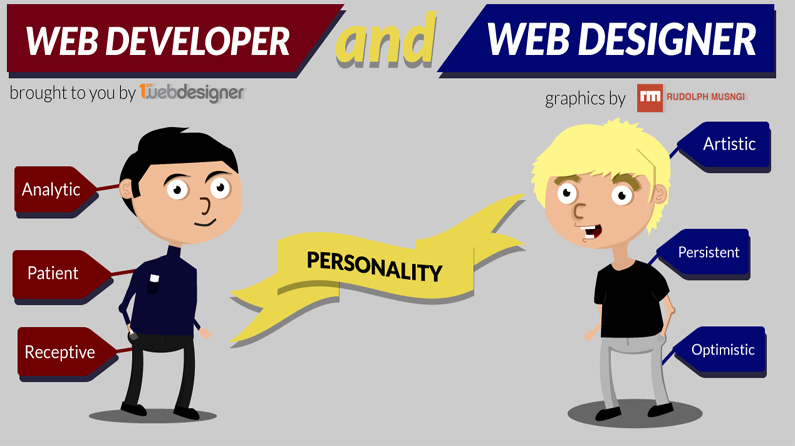In the dynamic realm of the internet, websites serve as the digital storefronts, informative hubs, and interactive experiences that shape our online interactions. But what breathes life into these virtual spaces? The answer lies in the collaborative efforts of two crucial professions: web developers and web designers. While their titles may sound interchangeable at first glance, these roles encompass distinct skillsets and areas of focus, working in tandem to craft compelling web experiences.
The Architect: The Web Developer's Domain
Web developers are the architects of the web, responsible for translating creative visions into functional realities. They wield the power of code, meticulously crafting the foundational structure and technical underpinnings that make a website tick. Here's a deeper dive into their world:
Masters of Code: Web developers possess a strong understanding of various programming languages, such as HTML, CSS, JavaScript, Python, and more. They utilize these languages to build web pages, integrate interactive elements, and ensure seamless communication between the user's browser and the website's server.
Front-End vs. Back-End: The web development landscape can be further divided into front-end and back-end development. Front-end developers focus on the user-facing aspects of a website, crafting the visual elements, layouts, and interactive features that users directly interact with. Back-end developers, on the other hand, delve into the website's unseen machinery, building and maintaining databases, servers, and application logic that power the website's functionality.
Full-Stack Flexibility: Some developers possess a versatile skillset encompassing both front-end and back-end expertise, known as full-stack developers. They can seamlessly navigate the entire web development process, offering a well-rounded skillset for smaller teams or projects requiring a unified approach.
The Artist: The Web Designer's Creative Canvas
Web designers are the artists of the web, wielding their creative vision to craft user interfaces (UIs) that are not only aesthetically pleasing but also intuitive and user-friendly. Here's a glimpse into their creative process:
User Experience (UX) Champions: UX designers champion the user's perspective. They conduct research, analyze user behavior patterns, and leverage design principles to create website layouts and functionalities that cater to user needs and expectations. Their focus lies on crafting a smooth and engaging user journey.
The Power of Visuals: UI designers translate UX concepts into visually appealing interfaces. They possess expertise in design software like Adobe Photoshop and Figma, meticulously crafting layouts, selecting color palettes, and incorporating visual elements that resonate with the target audience. Their aim is to create an interface that is not only aesthetically pleasing but also clear, intuitive, and promotes user engagement.
Design Specialization: Similar to web development, web design can be further specialized. Visual designers focus primarily on the aesthetic aspects of a website, while UI/UX designers combine visual design principles with user experience considerations to create well-rounded interfaces.
The Synergy: Orchestrating a Cohesive Web Experience
While web developers and web designers possess distinct skillsets, their roles are beautifully intertwined. They collaborate throughout the web development process, ensuring a website functions flawlessly and delivers an exceptional user experience.
Bridging the Gap: Web designers translate client visions and user needs into design mockups and prototypes. Web developers then bridge the gap, transforming these visual representations into functional code that brings the website to life.
Iterative Refinement: The development process is rarely linear. Web designers and developers often engage in an iterative cycle of creation, feedback, and refinement. Designers may adjust their mockups based on technical feasibility, while developers may suggest alternative approaches to achieve the desired user experience.
The Bigger Picture: Both web developers and web designers understand that a successful website is more than just aesthetics or functionality. They collaborate to ensure the website is not only visually appealing and user-friendly but also optimized for search engines, mobile responsiveness, and overall performance.
Choosing Your Path: Web Development vs. Web Design
If you're considering a career in the exciting world of web creation, understanding the differences between web development and web design can help you choose the path that best aligns with your skills and interests:
Analytical Mind vs. Creative Vision: Web development thrives on an analytical and problem-solving mindset. If you enjoy delving into code, tackling technical challenges, and building intricate systems, web development might be a perfect fit. Web design, on the other hand, caters to creative individuals who possess a keen eye for aesthetics, an understanding of user psychology, and a passion for crafting intuitive interfaces.
Technical Skills vs. Design Expertise: Web development necessitates a strong foundation in programming languages and frameworks. Web design, however, prioritizes design principles, visual communication skills, and proficiency in design software.


